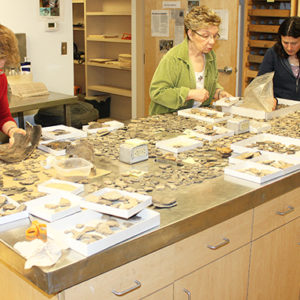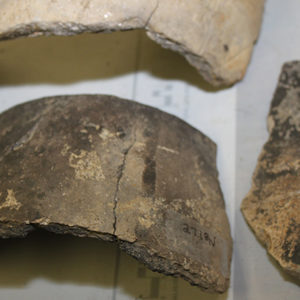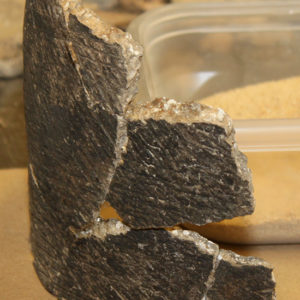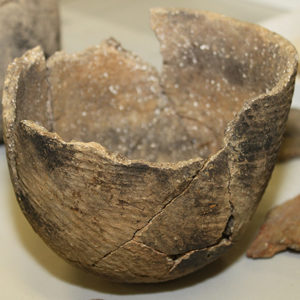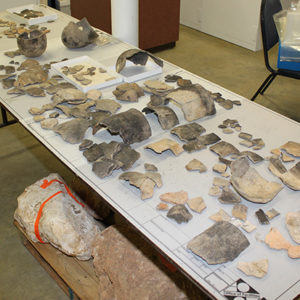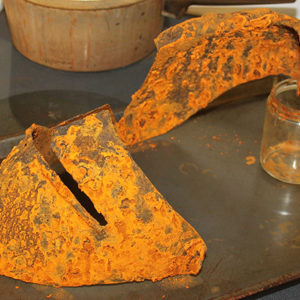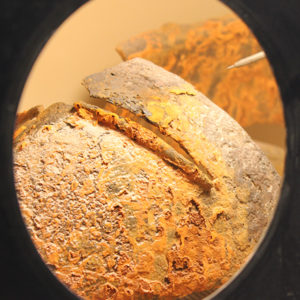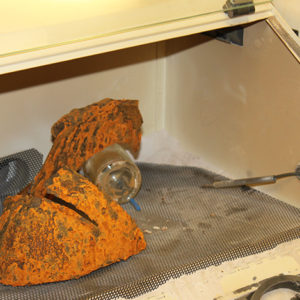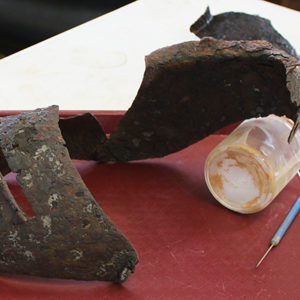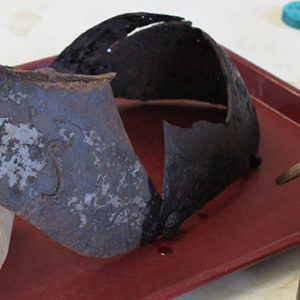As the archaeological field crew prepares to head back out to the fort site to continue their excavations of the 1608 church, the conservation and curatorial teams continue to process the thousands of artifacts that were found in a well likely constructed in 1609 under the direction of Captain John Smith. Thousands of sherds of Virginia Indian pottery have taken the place of last month’s animal remains on the lab tables, and curators and volunteers are sorting them by color, texture, pattern, and thickness in order to mend them back into the vessels they once were. Senior Conservator Michael Lavin is completing the final steps in preserving the visor and bevor of an iron close burgonet helmet found in a cellar in May 2007. Once ready, the close burgonet helmet will be exhibited in the Archaearium.
Strewn across one of the large metal tables like so many pieces of a puzzle are hundreds of sherds of Virginia Indian pottery found in the 1609 well two years ago. Each piece is labeled by the feature number and layer in which it was found, and the curatorial staff and volunteers are poring over them, looking for similar colors, patterns, and thicknesses that might indicate some came from the same vessel. The seasoned eyes and hands of the curatorial team are slowly but surely piecing together several pots from the conglomeration. These pots, though made by Virginia Indian hands, were being used in James Fort by the English settlers. Made of clay and tempered with oyster shell or crushed quartz, the vessels were coil constructed. On many, a thong-wrapped paddle was hit against the outside of the pot leaving a decorative cross-hatch pattern known as simple stamping. Other pots found in the well have smoothed exteriors.
In the same room, Senior Conservator Michael Lavin has removed an incomplete close burgonet in the final steps of the lengthy conservation process for the iron helmet. The object had been submerged in deionized water for two years to remove chlorides and then placed in the oven on low heat for about four hours to remove moisture. From the oven, Lavin carefully carried the helmet into the air abrasion room, where he removed the flash rust caused by the deionized water soaking. This is followed by several applications of a tannic acid solution that provides a protective barrier between the iron and the surrounding air. A final acrylic coating is then applied as a further protectant and the helmet is ready to be seen by visitors to the Voorhees Archaearium archaeological museum just yards from where it was found in James Fort. The conservation team hopes to have the display case ready so that the helmet will go on display at the end of 2011. For a more in-depth explanation of the process of iron artifact conservation, please see November 2010’s update.
Opening day of the archaeological dig season is April 9. Excavations will be focused on the fort’s first substantial church, built in 1608 and being the likely location for Pocahontas’ baptism and her marriage to John Rolfe. Visitors are encouraged to share in the moment of discovery as last year’s tarps are removed and the Jamestown Rediscovery archaeologists use their trowels to unpeel the earthen layers to reveal what has not been seen for over four centuries.
related images
- Volunteers Gere Brown and Norma Hamilton and Archaeologist Mary Anna Richardson sort through the Virginia Indian pottery sherds
- A partially-mended Virginia Indian pot
- Virginia Indian pottery with a smooth exterior
- A semi-mended Virginia Indian pottery vessel bearing a simple-stamp pattern
- A Virginia Indian pot with a simple-stamped exterior pattern
- Another table of Virginia Indian pottery found in the 1609 well
- Fresh out of the oven, the close helmet covered with flash rust
- The close helmet being treated with air abrasion to remove flash rust
- The close helmet in the air abrasion chamber
- Senior Conservator Michael Lavin coats the iron helmet with the first of several tannic acid applications to protect it from the elements
- The same view after application of the solution
- The close helmet after removal of the flash rust
- A portion of the helmet before application of the tannic acid solution



